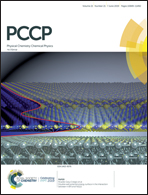Density functional approach to the description of the structure of dimer nanoparticles at liquid–liquid interfaces
Abstract
An extension of the density functional approach from our recent work (Phys. Chem. Chem. Phys., 2019, 21, 3073–3082) is developed. It permits us to study the microscopic structure and thermodynamic properties of chain particles at the interface between two partially miscible liquids. Explicit calculations are carried out for a binary symmetric mixture of hard-sphere Yukawa fluids and dimers built of hard-sphere segments. The model is simple, but it captures the interplay between localization of dimers at the interface and their orientation and assembly into layers. The segment density profiles are combined with the site superposition approximation to interpret angle-dependent local densities of dimers. Emphasis is put on self-organization of dimers. The evolution of the interfacial structure of dimers and of fluid species with the amount of added dimers and of the supporting mixture density is explored. Preferential orientations of dimers in the outer and inner layers of the interface are discovered. Changes of the interface width upon changing the parameters of the system are discussed. Similarities and differences between the properties of the interface hosting diatomic and spherical particles are explained.



 Please wait while we load your content...
Please wait while we load your content...